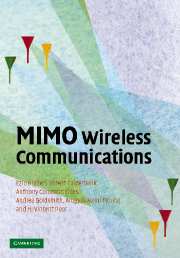Book contents
4 - Space–time coding for wireless communications: principles and applications
Published online by Cambridge University Press: 15 December 2009
Summary
Introduction
The essential feature of wireless transmission is the randomness of the communication channel which leads to random fluctuations in the received signal commonly known as fading. This randomness can be exploited to enhance performance through diversity. We broadly define diversity as the method of conveying information through multiple independent instantiations of these random fades. There are several forms of diversity; our focus in this chapter will be on spatial diversity through multiple independent transmit/receive antennas. Information theory has been used to show that multiple antennas have the potential to dramatically increase achievable bit rates, thus converting wireless channels from narrow to wide data pipes.
The earliest form of spatial transmit diversity is the delay diversity scheme proposed in where a signal is transmitted from one antenna, then delayed one time slot, and transmitted from the other antenna. Signal processing is used at the receiver to decode the superposition of the original and time-delayed signals. By viewing multiple antenna diversity as independent information streams, more sophisticates transmission (coding) scheme can be designed to get closer to theoretical performance limits. Using this approach, we focus on space-time coding (STC) schemes defined by Tarokh et al. and Alamouti, which introduce temporal and spatial correlation into the signals transmitted from different antennas without increasing the total transmitted power or the transmission bandwidth. Therefore is, in fact, a diversity gain that results from multiple paths between the base-station and the user terminal, and a coding gain that results from how symbols are correlated across transmit antennas.
Information
- Type
- Chapter
- Information
- MIMO Wireless Communications , pp. 140 - 185Publisher: Cambridge University PressPrint publication year: 2007
